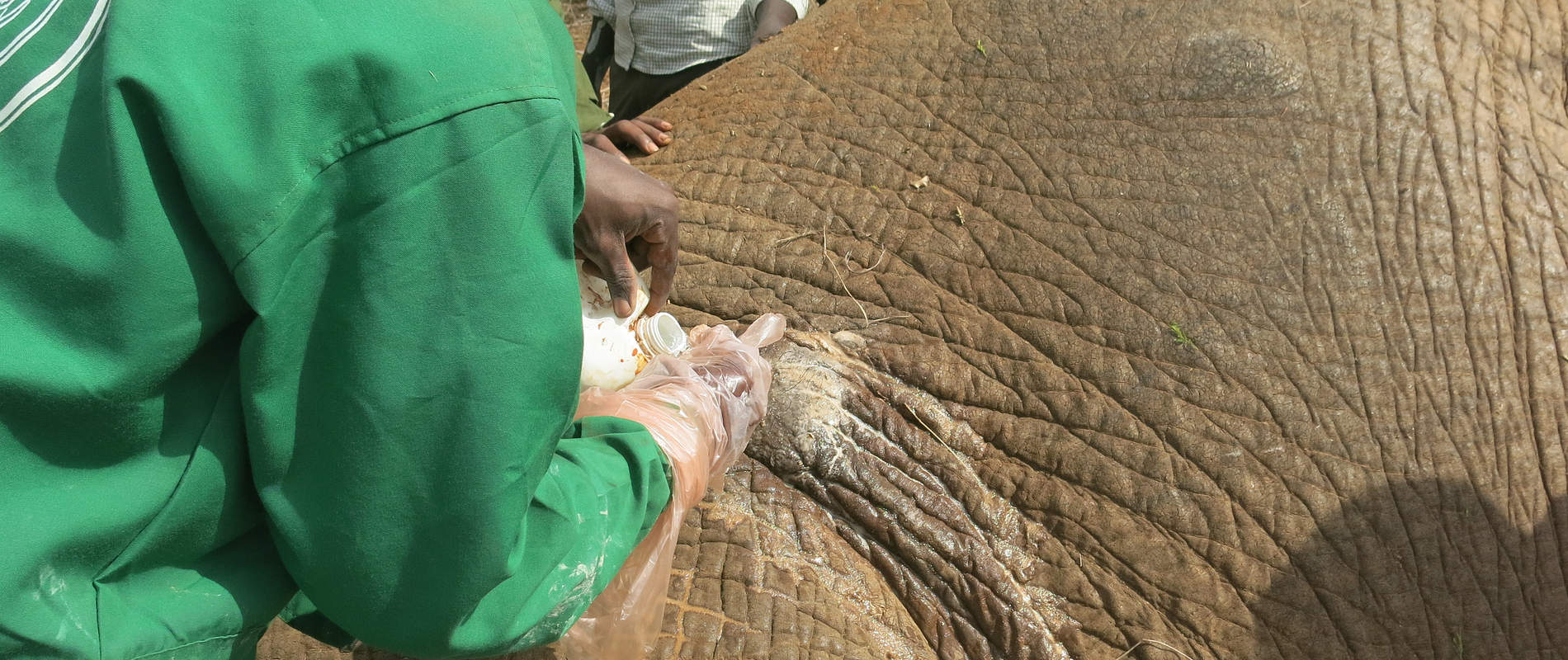MONTHLY REPORT - VETERINARY CLINICAL INTERVENTIONS FOR THE SOUTHERN CONSERVATION AREA (MVU) – AUGUST 2015 Report by; Dr
MONTHLY REPORT - VETERINARY CLINICAL INTERVENTIONS FOR THE SOUTHERN CONSERVATION AREA (MVU) – AUGUST 2015
Report by; Dr. Michael Njoroge
Monitoring and surveillance in Amboseli National Park, Tsavo West National park and the surrounding ecosystem
The team was welcomed back from a short break by a series of cases spanning the entire Tsavo Conservation Area (TCA). The majority of the species treated was the African elephant with injuries on various parts of the body. In all instances, the team’s response was instant thanks to the ample equipment and resources, such as the team’s fully equipped mobile vehicle, helicopter and the fixed wing aircraft, as well as associated personnel all of whom worked tirelessly to attend to the enormous work load.
The team also continued with the normal routine patrols and also conducted a 4 hour air recce within the entire Amboseli and Tsavo ecosystem aided by the DSWT light aircraft. All cases that required clinical intervention were attended to promptly.
CASE#1 EUTHANASIA OF AN INJURED IMPALA
Date: 13th Aug 15
Species: Impala
Sex: Male
Age: Adult
Location: Amboseli-Kimana Road
GPS coordinates
History
A male impala was spotted lame by the veterinary team while on their way to attend to another case. It is likely to have been hit by a car on the Amboseli-Kimana road in the early morning hours.
Treatment and examination
The impala was recumbent and immobile hence immobilization was not necessary for examination and assessment.
On physical examination the impala had suffered from compound fractures of both hind limbs, the left forelimb and a severed left horn.
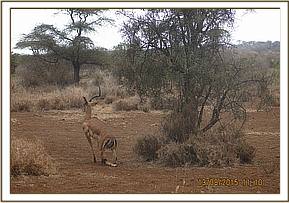

Prognosis
A decision to euthanize the impala using 20 ml euthanize was made. No clinical intervention could be done. The carcass was well disposed and the relevant authorities informed.
CASE#2 TREATMENT OF AN ELEPHANT WITH AN ARROW INJURY
Date: 14th Aug 15
Species: Elephant
Sex: Male
Age: Adult (40 – 45 years)
Location: Ithumba
History
The DSWT rangers reported to have seen a male elephant with a suspected arrow head injury on the left hind quarters. The DSWT helicopter collected the vet team from Amboseli and flew to the location to search for the injured elephant. The elephant was finally spotted in thick bush and in the midst of its family.
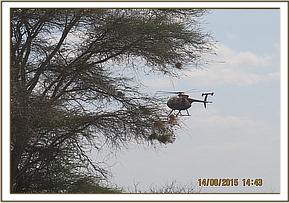

Immobilisation, examination and treatment
The elephant was immobilised with 18mg Etorphine topped up with water for injection in a 3 ml dan - inject dart using the Dan Inject system from a helicopter. The elephant first went down on sternal recumbence after 8 minutes and was then flipped over to lateral recumbence using a tractor. The trunk was maintained patent using a piece of stick placed across the nostril entrances. The temperature was high hence plenty of water was doused on the elephant to keep the body temperature low. The ears were used as blindfold.
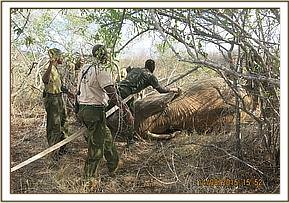

On physical examination the elephant had a penetrating wound to the left hindquarters. The wound was septic and had necrotic tissue. The wound is likely to have been caused by an arrow which had fallen off with time. The dead tissue was debrided and removed.
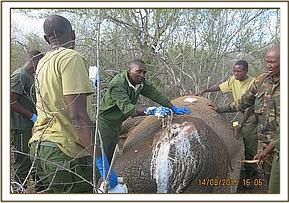

The wound were then thoroughly cleaned using clean water and Hydrogen Peroxide. It was then lavaged using tincture of Iodine. Topical antibiotic cream and green clay was then applied into the wound to facilitate healing and avoid infection. The elephant was then injected with 100 ml Betamox L.A, 1200 mg and 100 ml Dexamethasone at different sites intramuscularly. The entire operation lasted about 30 minutes.


Reversal
The anaesthetic was reversed using 60mgs Diprenorphine Hydrochloride into the ear vein. It took 45 minutes to get up and walk away from the site.
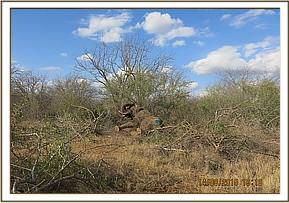

Prognosis
Good
Pictorial presentation;
CASE#3 TREATMENT OF AN ELEPHANT WITH ARROW INJURIES
Date: 15th Aug 15
Species: Elephant
Sex: Male
Age: Adult (40 – 45 years)
Location: Ithumba, Tsavo East
History
The DSWT rangers reported to have spotted a male elephant with a suspected arrow injury to the left thoracic region. The veterinary team located the elephant at the water hole.
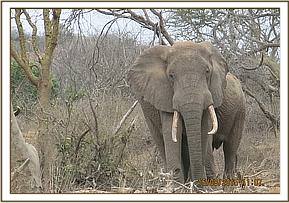
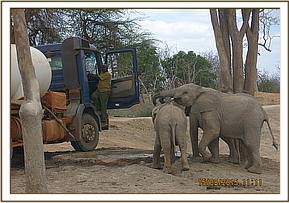
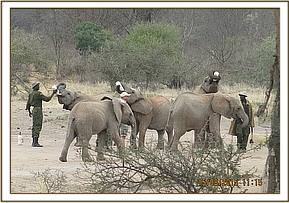

Immobilisation, examination and treatment
The elephant was immobilised with 18mg Etorphine topped up with water for injection in a 3 ml dan - inject dart using the Dan Inject system from a vehicle. The elephant went down on lateral recumbence after 8 minutes. It was then flipped over by the vehicle for easy access of the wound. The trunk was maintained patent using a piece of stick placed across the nostril entrances. The temperature was high hence plenty of water was doused on the elephant to keep the body temperatures low. The ears were used as blindfold.
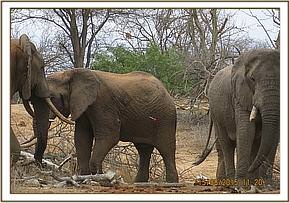
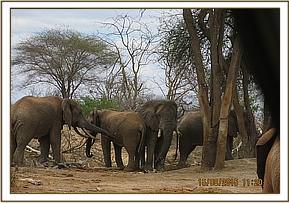
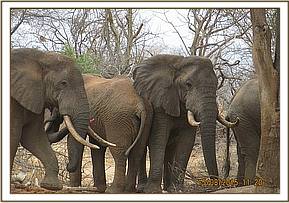

On physical examination the elephant had a penetrating wound to the left thoracic region. The wound was septic with necrotic tissue and was most likely inflicted by an arrow. The dead tissue was debrided and removed. The wounds were then thoroughly cleaned using clean water and Hydrogen Peroxide.
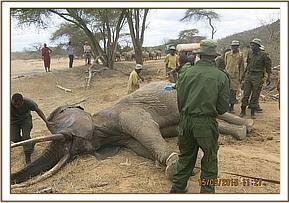

It was then lavaged using tincture of Iodine. Topical antibiotic cream and green clay was then applied into the wound to facilitate healing and avoid infection. The elephant was then injected with 100 ml Betamox L.A, 1200 mg Clindamycin and 100 ml Dexamethasone at different sites intramuscularly. The entire operation lasted about 30 minutes.


Reversal
The anaesthetic was reversed using 60mgs Diprenorphine Hydrochloride into the ear vein. It took 4.5 minutes to get up and walk away from the site.
Prognosis
Good
CASE#4 TREATMENT OF AN ELEPHANT WITH ARROW INJURIES
Date: 19th Aug 15
Species: Elephant
Sex: Male
Age: Adult (40 – 45 years)
Location: Komboyo, Tsavo West
History
The KWS Komboyo staff reported to have spotted a male elephant with a suspected arrow injury to the left hind quarters. The Trusts helicopter collected the vet team from Amboseli and went in search of the elephant which was finally spotted at a water hole near the Komboyo campsite. Though the injured individual was in the midst of a large herd, it was successfully darted from the Trusts helicopter. The rest of the herd was herded away by both the helicopter and a vehicle to pave way for subsequent procedures.


Immobilization, examination and treatment
The elephant was immobilised with 18mg Etorphine topped up with water for injection in a 3 ml dan - inject dart using the Dan Inject system from a vehicle. The elephant went down onto lateral recumbence after 11 minutes. The trunk was maintained patent using a piece of stick placed across the nostril entrances. The temperature was high hence plenty of water was doused on the elephant to keep the body temperatures low. The ears were used as blindfold.
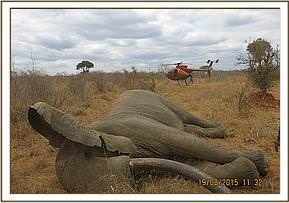

On physical examination the elephant had a penetrating wound to the left hindquarters. The wound was septic with necrotic tissue and most likely caused by an arrow. The dead tissue was debrided and removed before the wound were thoroughly cleaned using clean water and Hydrogen Peroxide.
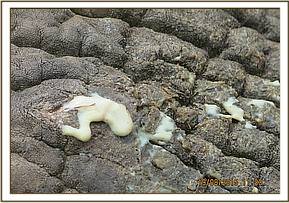

It was then lavaged using tincture of Iodine and topical antibiotic cream and green clay was applied into the wound to facilitate healing and avoid infection. The elephant was then injected with 200 ml Betamox L.A, 1200 mg and 100 ml Dexamethasone at different sites intramuscularly. The entire operation lasted about 20 minutes.
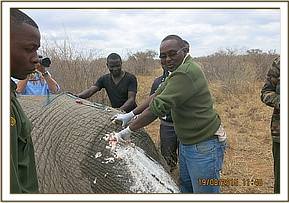

Reversal
The anesthetic was reversed using 60mgs Diprenorphine Hydrochloride into the ear vein. It took 5 minutes to get up and walk away from the site.
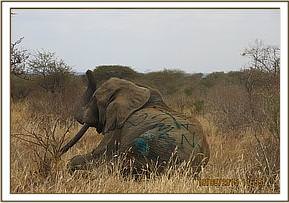

Prognosis
Good
CASE#5 TREATMENT OF AN ELEPHANT WITH AN ARROW WOUND
Date: 19th Aug 15
Species: Elephant
Sex: Male
Age: Adult (35 – 40 years)
Location: Komboyo, Tsavo West
History
The DSWT pilot and vet surgeon while on their search for another reported case spotted an injured elephant in the area. The terrain was bushy and therefore darting from a helicopter was the best option.
Immobilization, examination and treatment
The elephant was immobilised with 18mg Etorphine topped up with water for injection in a 3 ml dan - inject dart using the Dan Inject system from a vehicle. Full immobilization took place after 7 minutes and he fell on lateral recumbency. The elephant was then flipped over using a land cruiser to access the wound. The trunk was maintained patent using a piece of stick placed across the nostril entrances. The ears were used as blindfold. Water was doused on the ear pinnae due to the high temperatures of the Tsavo area.


On physical examination the elephant had a small wound to the right flank region. The wound was lightly septic and most likely caused by an arrow. The wound was thoroughly cleaned using water and Hydrogen Peroxide. It was then lavaged using tincture of Iodine. Topical antibiotic cream and green clay was then applied into the wound to facilitate healing and avoid infection. The elephant was then injected with 100 ml Betamox L.A at different sites intramuscularly. The entire operation lasted about 15 minutes.
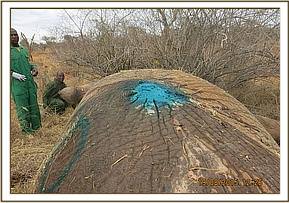

Reversal
The anesthetic was reversed using 54mgs Diprenorphine Hydrochloride into the ear vein. It took 6 minutes to get up and walk away from the site.
Prognosis
Prognosis is good
CASE#6 TREATMENT OF AN ELEPHANT WITH A SPEAR WOUND
Date: 19th Aug 15
Species: Elephant
Sex: Male
Age: Adult (30 – 35 years)
Location: Komboyo, Tsavo West
History
This elephant was also spotted while doing treatment of the second case. The elephant was in a bush but relatively easy to dart using the helicopter after it was seen from the light aircraft.
Immobilization, examination and treatment
The elephant was immobilized using 18 mgs Etorphine Hydrochloride in a 3cc dart topped up using water the Dan Inject system from a helicopter. The elephant went down on lateral recumbence after 6 minutes. He was then flipped over to access the wound on the right flank. The trunk was maintained patent using a piece of stick placed across the nostril entrances. The temperature was high hence plenty of water was doused on the elephant to keep the body temperatures low. The ears were used as blindfold.
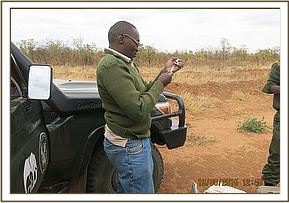

On physical examination the elephant had an approximately 15 cm long wound (1 month old) on the right lower flank region. The wound was septic and had necrotic tissue. An incision was made distal to the wound where there was a pus pocket to allow access and drainage of pus. The wound had been caused by a spear likely to have been thrown from a platform. About 0.8 kg of necrotic tissue was debrided and 2 liters of pus drained. The wound was then thoroughly cleaned using water and Hydrogen Peroxide.
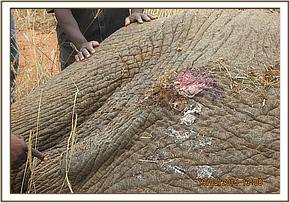

It was then lavaged using tincture of Iodine. Topical antibiotic cream and green clay was then packed into the wound to facilitate healing and avoid infection. The elephant was then injected with 200 ml Betamox L.A and 100 ml Dexamethasone at different sites intramuscularly. The entire operation lasted about 45 minutes.
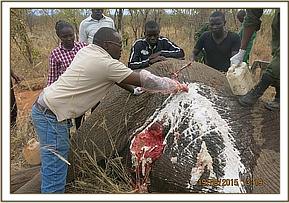

Reversal
The anesthetic was reversed using 54mgs Diprenorphine Hydrochloride into the ear vein. It took 6 minutes to get up and walk away from the site.
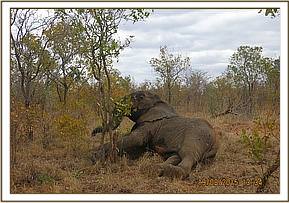

CASE#7 TREATMENT OF AN ELEPHANT WITH AN ARROW WOUND
Date: 19th Aug 15
Species: Elephant
Sex: Male
Age: Adult (40 – 45 years)
Location: Komboyo, Tsavo West
History
The KWS Komboyo staff reported to have spotted a male elephant with a suspected arrow injury to the right hindquarters. The Trust helicopter went in search of the elephant.
Immobilization, examination and treatment
The elephant was immobilized using 18 mgs Etorphine Hydrochloride in a 3cc dart topped up using water the Dan Inject system from a helicopter. The elephant bull initially went down to a sternal recumbence after 10 minutes and was quickly assisted to an appropriate lateral recumbence position making sure that the wound remained accessible for treatment. The trunk was maintained patent using a piece of stick placed across the nostril entrances. The temperature was high hence plenty of water was doused on the elephant to keep the body temperatures low. The ears were used as blindfold.


On physical examination the elephant had a penetrating wound to the right hip. The wound, most likely inflicted by a poisoned arrow, was septic with necrotic tissue.
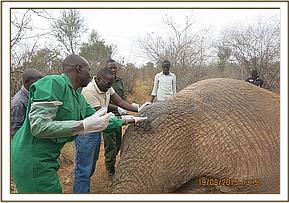

The dead tissue was debrided, removed and then thoroughly cleaned using clean water and Hydrogen Peroxide.
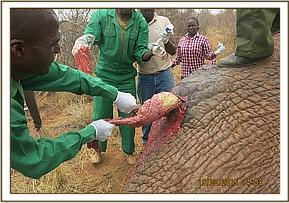

It was then lavaged using tincture of Iodine. Topical antibiotic cream and green clay was then applied into the wound to facilitate healing and avoid infection. The elephant was then injected with 200 ml Betamox L.A and 100 ml Dexamethasone at different sites intramuscularly. The entire operation lasted about 30 minutes.
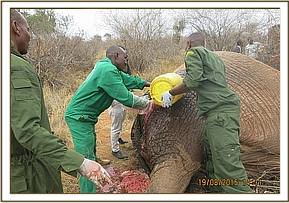

Reversal
The anesthetic was reversed using 60mgs Diprenorphine Hydrochloride into the ear vein. It took 4 minutes to get up and walk away from the site.
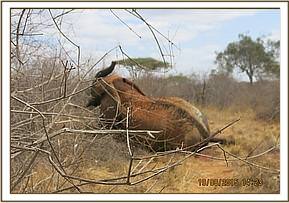

Prognosis
Good
CASE#8 TREATMENT OF AN ELEPHANT WITH AN ARROW WOUND
Date: 19th Aug 15
Species: Elephant
Sex: Male
Age: Adult (35 – 40 years)
Location: Komboyo, Tsavo West
History
This elephant was spotted whilst searching for the previous patient. It had a fairly large swelling on the left flank region with a little oozing pus. With an already prepared dart, this was immobilized and attended to.
Immobilization, examination and treatment
The elephant was immobilized using 18 mgs Etorphine Hydrochloride in a 3cc dart topped up using water the Dan Inject system from a helicopter. After 14 minutes, the bull went recumbent but on the wrong side and was thus rolled over to expose the wounded side for treatment. The trunk was maintained patent using a piece of stick placed across the nostril entrances. The temperature was high hence plenty of water was doused on the elephant to keep the body temperatures low. The ears were used as blindfold.
On physical examination the elephant had a healing wound with a little pus. The wound, most likely inflicted by an arrow, was thoroughly cleaned using clean water and Hydrogen Peroxide. It was then lavaged using tincture of Iodine. Topical antibiotic cream and green clay was then applied into the wound to facilitate healing and avoid infection. The elephant was then injected with 200 ml Betamox L.A and 100 ml Dexamethasone at different sites intramuscularly. The entire operation lasted about 10 minutes.
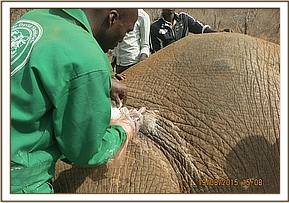

Reversal
The anesthetic was reversed using 60mgs Diprenorphine Hydrochloride into the ear vein. It took 4 minutes to get up and walk away from the site.


Prognosis
Good
CASE#9 TREATMENT OF AN ELEPHANT WITH AN ARROW WOUND
Date: 20th Aug 15
Species: Elephant
Sex: Male
Age: Adult (40 – 45 years)
Location: Komboyo, Tsavo West
History
The elephant was spotted while searching for another case on a helicopter in Komboyo area. The elephant was darted from a helicopter.
Immobilization, examination and treatment
The elephant was immobilized using 18 mgs Etorphine Hydrochloride in a 3cc dart topped up using water the Dan Inject system from a helicopter. The elephant went down in a dog sitting position after 9 minutes. He was the pushed over to lateral recumbence. The trunk was maintained patent using a piece of stick placed across the nostril entrances. The temperature was high hence plenty of water was doused on the elephant to keep the body temperatures low. The ears were used as blindfold.
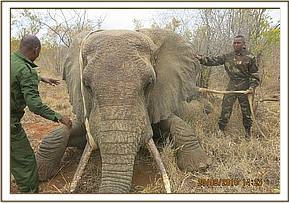

On physical examination the elephant had an approximately 10 cm long wound (approx. 1 month old) on the right lower flank region.
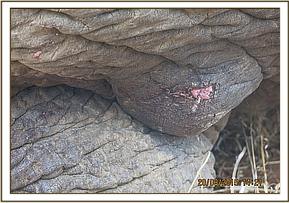

The wound was septic and had necrotic tissue. An incision was made distal to the wound where there was a pus pocket to allow access and drainage of pus. The wound had been caused by an arrow head which was removed and about 1.5 kg of necrotic tissue was debrided.
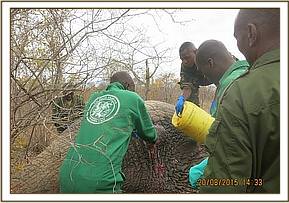
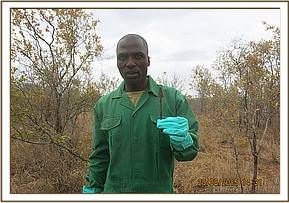
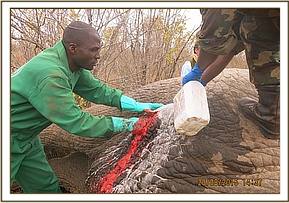

The wound was then thoroughly cleaned using water and Hydrogen Peroxide. It was then lavaged using tincture of Iodine. Topical antibiotic cream and green clay was then applied into the wound to facilitate healing and avoid infection. The elephant was then injected with 200 ml Betamox L.A and 100 ml Dexamethasone at different sites intramuscularly. The entire operation lasted about 30 minutes.
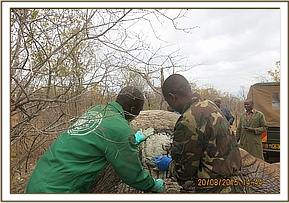

Reversal
The anesthetic was reversed using 60mgs Diprenorphine Hydrochloride into the ear vein. It took 4 minutes to get up and walk away from the site.
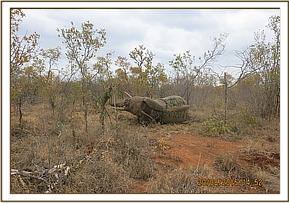

CASE#10 TREATMENT OF AN ELEPHANT WITH AN ARROW WOUND
Date: 20th Aug 15
Species: Elephant
Sex: Male
Age: Adult (30 – 35 years)
Location: Komboyo, Tsavo West
History
The adult male elephant was spotted within the park while performing an aerial reece in a helicopter. A serious sceptic wound was visible from the helicopter. A decision was made to immobilize and treat the elephant. Darting was relatively easy from the DSWT helicopter though the terrain was rough and bushy.
Immobilization, examination and treatment
The elephant was immobilized using 17 mgs Etorphine Hydrochloride in a 3cc dart topped up using water the Dan Inject system from a helicopter. Darting was done using Dan-inject system from the helicopter. Full immobilization took place after 5 minutes and he fell on lateral recumbency. With the help of a land cruiser, the elephant was flipped over for easy access to the wound. The trunk was maintained patent using a piece of stick placed across the nostril entrances. The ears were used as blindfold. Plenty of water was doused on the ears (pinnae) and the entire body to help cool the elephant during the operation.
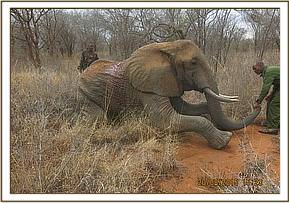

On examination, the elephant was weak and had poor body condition. He had a serious wound to the dorsal thoracic region and about 5 cm from the spine. The wound was deep (aprox. 90 cm), with a clean cut, septic and most likely to have been caused by a spear thrown from a platform. The dead tissue was debrided and removed. The wound was then thoroughly cleaned using water and Hydrogen Peroxide. It was then lavaged using tincture of Iodine. Topical antibiotic cream, spray and green clay was then applied into the wound to facilitate healing and avoid infection. The elephant was then injected with 200 ml Amoxcycillin L.A 20% and 100 ml Flunixine meglumine and at different sites intramuscularly. The entire operation lasted about 40 minutes.
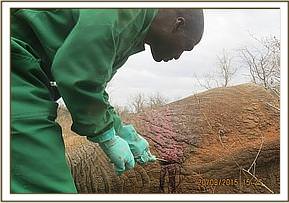

Reversal
The anesthetic was reversed using 54mgs Diprenorphine Hydrochloride into the ear vein. Due to his weakness, the elephant had to be assisted to get up using straps with the help of rangers.
Prognosis
Prognosis is guarded and a second treatment is necessary. Monitoring of this elephant is ongoing.
CASE#11 TREATMENT OF AN ELEPHANT WITH AN ARROW WOUND
Date: 21st Aug 15
Species: Elephant
Sex: Female
Age: Adult (25 – 30 years)
Location: Komboyo, Tsavo West
History
This mother elephant was spotted while doing an aerial reece on the helicopter after treating another case. The wound was serious and necessitated darting and treatment. The elephant was darted from a helicopter.
Immobilization, examination and treatment
The elephant was immobilized using 17 mgs Etorphine Hydrochloride in a 3cc dart topped up using water the Dan Inject system from a helicopter. The elephant went down on dog sitting position after 7 minutes. Her calf would not leave her side and had to be chased away with the vehicle and the helicopter. She was the flipped over to access the wound. The trunk was maintained patent using a piece of stick placed across the nostril entrances. The temperature was high hence plenty of water was doused on the elephant to keep the body temperatures low. The ears were used as blindfold.
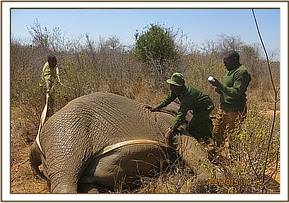

On physical examination the elephant had an approximately 20 cm long wound (approx. 1 month old) on the left lower flank region to the thoracic region. The wound was septic and had necrotic tissue. An incision was made distal to the wound where there was a pus pocket to allow access and drainage of pus from the wound. The wound had been caused by an arrow head which was removed and about 2 kg of necrotic tissue was debrided.


The wound was then thoroughly cleaned using water and Hydrogen Peroxide. It was then lavaged using tincture of Iodine. Topical antibiotic cream and green clay was then applied into the wound to facilitate healing and avoid infection. The elephant was then injected with 200 ml Betamox L.A and 100 ml Dexamethasone at different sites intramuscularly. The entire operation lasted about 40 minutes.
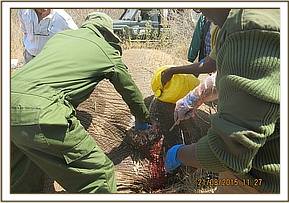

Reversal
The anesthetic was reversed using 54mgs Diprenorphine Hydrochloride into the ear vein. It took about 8 minutes to be fully awake from anesthesia. The helicopter was then used to driver her in the direction of her calf and the two were reunited.


Prognosis
Good
CASE#12 TREATMENT OF AN ELEPHANT WITH AN ARROW WOUND
Date: 21st Aug 15
Species: Elephant
Sex: Male
Age: Adult (20 – 25 years)
Location: Komboyo, Tsavo West
History
The DSWT pilot reported to have spotted a male elephant with a suspected arrow injury to the right limb. The veterinary team had to locate and assess the elephant from the helicopter since the vegetation was thick. The elephant was in a thick bush thicket but relatively easy to dart using the helicopter. The elephant was pushed to a relatively open ground for darting.
Immobilization, examination and treatment
The elephant was immobilized using 17 mgs Etorphine Hydrochloride in a 3cc dart topped up using water the Dan Inject system from a helicopter. The elephant went down on lateral recumbence after 8 minutes. The trunk was maintained patent using a piece of stick placed across the nostril entrances. The temperature was high hence plenty of water was doused on the elephant to keep the body temperatures low. The ears were used as blindfold.
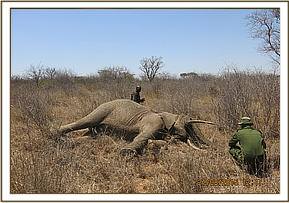

On physical examination the elephant had a penetrating wound to the right flank around the thoracic region. The wound was relatively fresh and likely to have been caused by an arrow head. The wound was then thoroughly cleaned using clean water and Hydrogen Peroxide. It was then lavaged using tincture of Iodine.
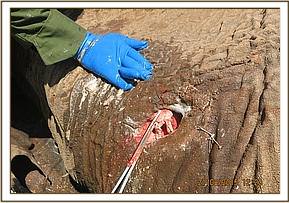

Topical antibiotic cream and green clay was then applied into the wound to facilitate healing and avoid infection. The elephant was then injected with 100 ml Betamox L.A and 50 ml Dexamethasone at different sites intramuscularly. The entire operation lasted about 25 minutes.
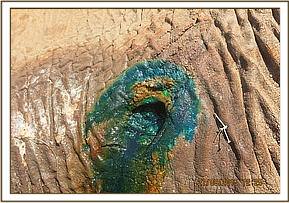

Reversal
The anesthetic was reversed using 60mgs Diprenorphine Hydrochloride into the ear vein. It took about 4.5 minutes to be fully awake from anesthesia.
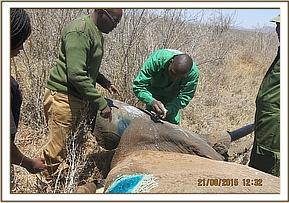

Prognosis
Good
CASE#13 TREATMENT OF AN ELEPHANT CALF
Date: 22nd Aug 15
Species: Elephant
Sex: Male
Age: Infant, 6 months
Location: Tsavo East
History
An elephant calf was reported by the Satao Elerai staff with a swollen left forelimb. The veterinary team attended to the case and decided to immobilize it for examination and treatment.
Immobilization, examination and treatment
Physical immobilization was the most appropriate for this young calf. However, the protective mother had to be immobilized first to enable capture of the young elephant. The mother elephant was immobilized using 17 mgs Etorphine Hydrochloride in a 2cc dart topped up using water for injection from a helicopter using the Dan-inject system. Full immobilization took place after 8 minutes and she fell on lateral recumbence. The trunk was maintained patent by the help of a piece of stick which was placed across at the entrances. The ears were used as blindfold. Water was doused on the elephant to cool her down since the temperatures were high. The calf was then physically captured after which 2mg Etorphine was administered intramuscularly to calm her during the treatment.
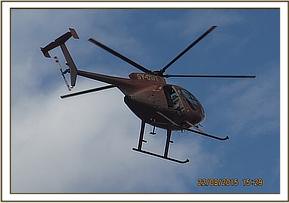

On physical examination the calf had an infected wound to the left forelimb around the hock joint region. The injury could have been as a result of a predator attack. On palpation no crepitation could be felt hence the team decided to go ahead and treat the young calf.
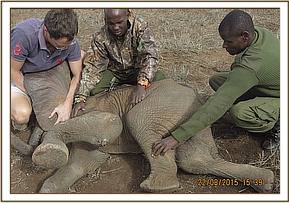

The dead tissue was debrided and the wound thoroughly cleaned using water and hydrogen peroxide. It was then lavaged using tincture of Iodine. The calf was injected with 20ml Betamox L.A, 3 vials Dalacin and 30ml Dexamethasone at different sites intramuscularly. Topical antibiotic ointment and grey clay was then applied on the wound to facilitate healing. The operation lasted 30 minutes.


Reversal
The anesthetic was reversed using 60mgs Diprenorphine Hydrochloride into the ear vein. It took about 4.5 minutes to be fully awake from anesthesia.
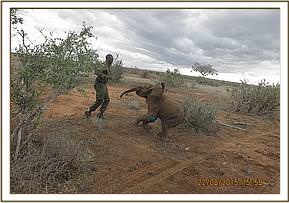

Prognosis
Good
CASE#14 TREATMENT OF A LION INJURED BY A BUFFALO
Date: 22nd Aug 15
Species: Lion
Sex: Male
Age: Sub Adult
Location: Sala Gate, Tsavo East
History
A male lion sub adult was spotted by rangers at Galana conservancy and reported to have been lame. The veterinary team immediately attended to the case and made a decision to immobilize and examine the lion.
Immobilization, examination and management
The lion was immobilized using 3.5 mgs Medetomidine and 280 mg Ketamine in a 3cc dart topped up with water using the Dan-inject system from a vehicle. Full immobilization took place after 5 minutes and he fell on lateral recumbence. The lion was blind folded and opticlox applied to the eyes.
On physical examination the lion had suffered from injuries from a buffalo around the head region. There was a fracture around the ocular region and she was very weak and had poor body condition.
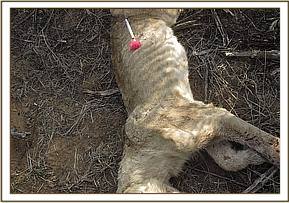

Prognosis
It was evident that the lioness had a poor prognosis even with treatment. She was euthanized using 20ml Euthanaze.
CASE#15 TREATMENT OF AN ELEPHANT WITH AN ARROW WOUND
Date: 23rd Aug 15
Species: Elephant
Sex: Male
Age: Adult (30 – 35 years)
Location: Komboyo, Tsavo West
History
The elephant was spotted from a helicopter during an aerial recce. The veterinary team made a decision to dart, examine and treat the elephant.
I Immobilization, examination and treatment
The elephant was immobilised with 18mg Etorphine topped up with water for injection in a 3 ml dan - inject dart using the Dan Inject system from the helicopter. The first dart failed to discharge the narcotic and hence a second dart had to be loaded. The elephant went down on lateral recumbence after 8 minutes following the second dart. The trunk was maintained patent using a piece of stick placed across the nostril entrances. The temperature was high hence plenty of water was doused on the elephant to keep the body temperatures low. The ears were used as blindfold.
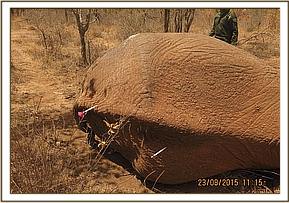

On physical examination the elephant had an approximately 4 cm long healing wound to the dorsal left hind limb. The wound had been caused by an arrow and the elephant attended to previously. This was therefore going to be the final treatment for this elephant who had responded very well to the first treatment. The wound was thoroughly cleaned using water and Hydrogen Peroxide. It was then lavaged using tincture of Iodine. Topical antibiotic cream and green clay was then applied into the wound to facilitate healing and avoid infection. The elephant was then injected with 100ml Betamox L.A, and 50ml Dexamethasone at different sites intramuscularly. The entire operation lasted about 25 minutes.
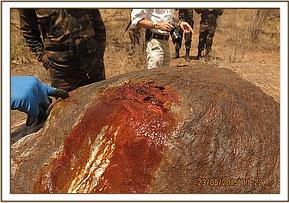

Reversal
The anesthetic was reversed using 54mgs Diprenorphine Hydrochloride into the ear vein. It took 4 minutes to get up and walk away from the site.
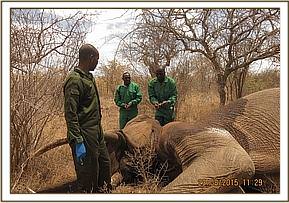

The Southern Conservation Area- Mobile Veterinary Unit is grateful to all individuals who played a role in assisting us towards achieving our goal. Many thanks to The David Sheldrick Wildlife Trust, The Samuel J and Ethel Lefrak charitable trust and The Kenya Wildlife Service for their continued support to this unit which aims at immediate response to clinical intervention, wildlife rescues and alleviating wildlife suffering.
